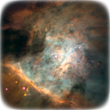































Why do astronomers choose the wavelength of light they study very deliberately? Stars form inside interstellar clouds of gas and dust. Not all of their light escapes. The longer the wavelength of light, the more it is able to travel unimpeded through a cloud. The ultraviolet and blue light from large very hot stars—as in the Trapezium—has shorter wavlengths than red and infrared light, which is characteristic of cool stars and still forming stars. Very red light has a wavelength of a milli-millimeter. In contrast, radio radiation has the longest wavelength—centimeters and meters—and in our lives, we experience its penetrating power everyday. Find out more from Professor Jonathan C. Tan.